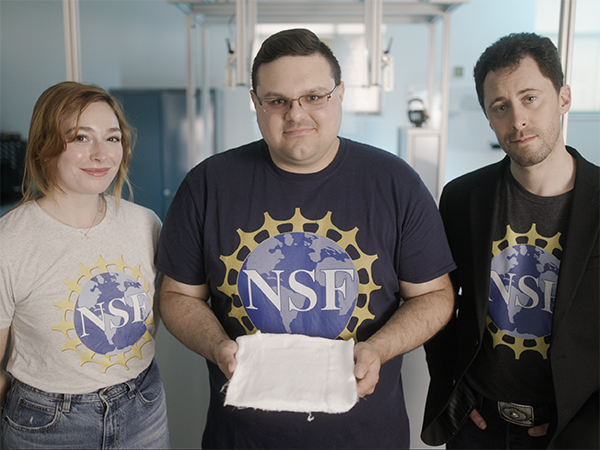Open the doors at TruSpin, and one’s eyes are immediately drawn to a machine spinning out a dense, wispy web onto an enormous spool suspended from above.
While this might look like a mad scientist’s method for making cotton candy, it’s actually the future of nanofiber manufacturing, and the nanofibers created have the potential for seismic impact in the scientific world.
Nanofibers have many possible applications, including tissue engineering, drug delivery, thermal insulation, lithium-ion batteries and air filtration, among others.
TruSpin is a University of Alabama at Birmingham start-up company that spun off technology patented by the UAB Bill L. Harbert Institute for Innovation and Entrepreneurship. Their alternating current electrospinning system enables the high-output production of long, aligned nanofibers. Other electrospinning systems cannot deliver the same product quality, which has inhibited the use of nanofibers in the many industries in which they could potentially deliver value.
TruSpin co-founders Robert Agnew and Anthony Brayer, Ph.D., envision their nanofibers as a foundational material in the creation of next-generation technologies – keeping firefighters safe with textiles that can withstand intense heat, re-growing lost tissue, extending the range of electric vehicles, and perhaps even enabling people to one day visit Mars.
While that last goal may sound lofty, Agnew details how TruSpin’s nanofibers could be part of future space missions – flexible thermal protection, advanced carbon fiber for cryogenic fluid tanks, and advanced catalysts for salvaging useful chemicals from waste. Jessica Lewis, Anthony Brayer and Robert Agnew. “Going to the moon remains the pinnacle of human achievement,” Agnew said. “If TruSpin’s materials one day play any role, however small, in enabling people to live on Mars, my highest hopes for contributing to humanity will be fulfilled.”
Jessica Lewis, Anthony Brayer and Robert Agnew. “Going to the moon remains the pinnacle of human achievement,” Agnew said. “If TruSpin’s materials one day play any role, however small, in enabling people to live on Mars, my highest hopes for contributing to humanity will be fulfilled.”
Brayer, who has received three degrees in physics from UAB – a bachelor’s, master’s and Ph.D. – said he got inspiration for TruSpin’s electrospinning system while studying abroad at a technical university in central Europe. There he saw a rudimentary version of an alternating current electrospinning machine and knew he was looking at the foundation of a breakthrough.
“The first time the switch was thrown, I knew it was something special. I recognized how a similar machine could be built that would have the ability to make a material with limitless potential at unmatched output levels,” he said.
Brayer said that over the years, scientists have produced miniscule amounts of the types of fibers that TruSpin specializes in and have documented the massive potential of such fibers, but no one has been able to find a way to easily produce them – until now.
“The promise of nanofibers’ impact has always come with the caveat of ‘if only we could reliably make these materials in reasonable quantities,’” Brayer said. “This technology turns ‘if only’ into ‘finally!’”
Brayer co-invented the AC electrospinning method with his mentor, Andrei Stanishevsky, Ph.D.
TruSpin, which has already won awards, grant money, and investments from the EDPA’s Alabama Launchpad pitch competition, the National Science Foundation, and Techstars, plans to submit a proposal to the NSF for approximately $750,000 in Phase II funding later this year.
Agnew said TruSpin is working towards establishing a collaboration with another firm to develop a new type of carbon fiber and hopes to soon find a collaborator working with biological polymers. He said that he also foresees many potential uses in life sciences, such as tissue engineering and regrowth and wound dressings.
“By the end of this decade – and a lot sooner if we have anything to do with it, nanofibers are going to impact every human on earth,” Agnew said. “The nanofiber market is growing at a compounding rate of almost 40 percent year over year, and we hold the keys to the manufacturing system that unlocks their industrial-scale production.”
For more information on TruSpin, visit www.tru-spin.com. To inquire about potential business collaborations, email